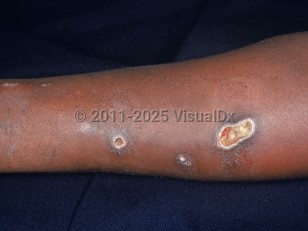Many complications from skin popping can occur:
- Barbiturate injection can cause tender, indurated, erythematous plaques that may develop into deep ulcers; infection occurs frequently.
- Pentazocine injection can cause swollen, hard, sclerodermatous skin thickening with large and deep (may reach to muscle) ulcers that are irregularly shaped. Cutaneous sclerosis from pentazocine injections is more common in diabetic patients.
- Tissue ischemia / infarction can result from highly vasoconstrictive drugs, such as cocaine.
- Adulterants such as lactose, mannitol, dextrose, baking soda, flour, and quinine are used to dilute heroin and other powder drugs and can be more damaging to tissue than the drug itself. Quinine and dextrose in particular are highly sclerosing, and chronic nonpitting edema can result from repeated injection of quinine, as it is destructive to lymphatics. Levamisole mixed into cocaine has been implicated in necrosis of the ears and cheeks. "Krokodil" is a homemade injectable opioid first noted in Russia, made by mixing codeine with lighter fluid, paint thinner, and other adulterants, that causes discolored scaly skin, ulceration, and necrosis.
- Wound botulism caused by Clostridium botulinum type A is especially associated with skin popping of black tar heroin.
- Granulomas can form from injection of talc (magnesium silicate) or starch. They may appear many years after subcutaneous injection.
- Fibrous myopathy, joint restriction, muscle contractures, neuropathy, ankylosis, and suppurative tenosynovitis may also occur.



